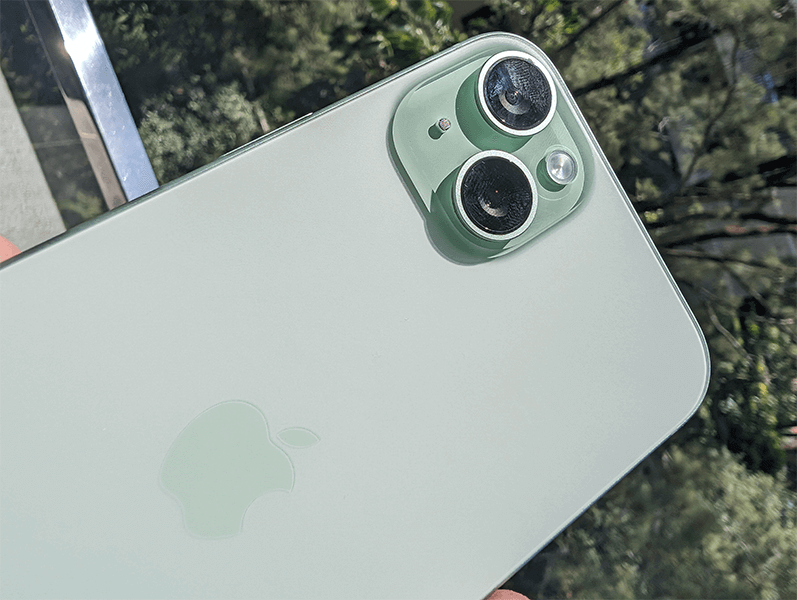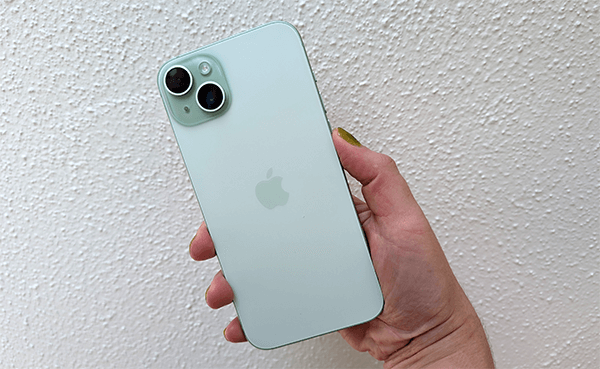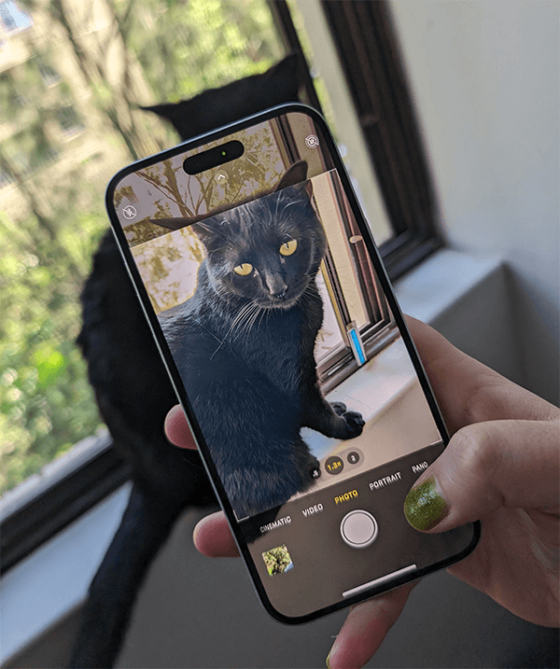Apple has finally achieved a fairly streamlined iPhone 15 line-up, with its 2023 range allowing customers to mix and match their choice of screen size and features. The iPhone 15 Plus is the super-sized version of the standard iPhone 15, with a big, bright 6.7-inch display that’s equal in size to the premium iPhone 15 Pro Max.
The iPhone 15 Plus packs in some great features and upgrades, including an improved camera lineup, longer battery life, and the addition of the Dynamic Island previously found in the iPhone 14 Pro. However, with finances tight in many households, the $1,649 asking price may be well out of reach for many prospective buyers.
Apple lovers will be happy with the company’s 2023 Plus device, but is there enough here to sway new converts to the brand? We took the gorgeous green iPhone 15 Plus on a lengthy test drive to see if it’s worth the money.
How we tested the iPhone 15 Plus
I used the iPhone 15 Plus over several weeks as my day-to-day smartphone, testing normal usage as well as intensive activities like streaming and gaming. I also tested out the iPhone’s cameras, and monitored its daily battery life.
Product used for review/testing was a free sample provided by Apple.

iPhone 15 Plus: key features and specs
- Priced from $1,649
- 6.7-inch Super Retina XDR display
- A16 Bionic Chip
- iOS 17 operating system
- MagSafe and QI wireless charging, up to 26 hours video playback
- IP68 water and dust resistance
- 5G connectivity
- Dual camera in rear (48-megapixel wide angle and 12-megapixel ultra-wide)
- 12-megapixel TrueDepth camera in front
- 128GB, 256GB and 512GB storage sizes
- Available in Black, Blue, Green, Yellow, Pink
| iPhone 15 Plus pros | iPhone 15 Plus cons |
|---|---|
|
|
On this page:
Phone plans for the iPhone 15 series
The following table compares a selection of 24-month 128GB iPhone 15 plans as published on Canstar Blue’s database, listed in order of their standard monthly cost, from the lowest to highest and then by data allowance, largest to smallest. Use our phone plan comparison tool to compare plans from a range of providers. This is a selection of products with links to a referral partner.
The following table compares a selection of 24-month 128GB iPhone 15 Plus plans as published on Canstar Blue’s database, listed in order of their standard monthly cost, from the lowest to highest and then by data allowance, largest to smallest. Use our phone plan comparison tool to compare plans from a range of providers. This is a selection of products with links to a referral partner.
The following table compares a selection of 24-month 128GB iPhone 15 Pro plans as published on Canstar Blue’s database, listed in order of their standard monthly cost, from the lowest to highest and then by data allowance, largest to smallest. Use our phone plan comparison tool to compare plans from a range of providers. This is a selection of products with links to a referral partner.
The following table compares a selection of 24-month 256GB iPhone 15 Pro Max plans as published on Canstar Blue’s database, listed in order of their standard monthly cost, from the lowest to highest and then by data allowance, largest to smallest. Use our phone plan comparison tool to compare plans from a range of providers. This is a selection of products with links to a referral partner.
Design and functionality
- Big display that stays bright in sunlight
- Premium design and feel
- Still no ProMotion/120Hz refresh rate
It’s been a minute since we’ve seen a major design change in the iPhone, and this year’s 15 range is mostly no different. You’ll get the same classic curved edges as the 14 range, with Apple again placing the rear camera house in the very top-left, placing each lens diagonally. However, 2023 is the year that Apple has finally said goodbye to its Lightning connector, so the entire 15 range is now USB-C compatible. This means you can finally share charging cables between your iPhone 15 and any other USB-C capable devices (including practically every Android phone).
Despite the generally standard design, the iPhone has been given a durability upgrade this year, incorporating an aluminium enclosure and custom-designed, colour-infused glass in the rear (which also makes the device more matte and easier to hold). The phone also offers splash and dust resistance, and held up fine after minor water exposure; while you probably shouldn’t throw the 15 Plus in your pool, it won’t be impacted by getting caught in the rain.
The 15 Plus’ screen measures in at a big 6.7 inches, so it’s a great device for on-the-go gaming and video playback. Apple has cranked up the brightness to a maximum of 2,000 nits (up from 1,200 in 2022), so the Plus fares even better in direct sunlight; overall, it’s a great display designed for clear viewing in a variety of lighting conditions. But unlike the 15 Pro and Pro Max, you won’t get an Always-On Display, and the refresh rate is limited to 60Hz (Apple’s ProMotion displays go up to 120Hz).
Both these omissions aren’t deal-breakers. But with plenty of mid-range phones now offering a faster 120Hz refresh rate for much lower prices, it does feel like Apple should be including these features as standard. The 15 Plus is still pleasant to use, even without the ultra-smooth scrolling and gaming 120Hz would offer, but here’s hoping that next year’s line-up incorporates these upgrades.

Using the phone
If you’re a seasoned Apple owner, there won’t be any surprises for you in the 15 Plus’ useability. Apple is near-unmatched in making its devices intuitive to use, and with iOS 17 included out-of-the-box, the 15 Plus is easy to both navigate and customise.
The biggest change over last year’s 14 and 14 Plus is the inclusion of Apple’s Dynamic Island, which is located in place of the previous front camera notch. Originally introduced in the iPhone 14 Pro and Pro Max, the Dynamic Island is essentially a top-screen widget that displays notifications and activities from a variety of apps. Some of the tasks Dynamic Island can do automatically include keeping track of Maps directions, flight delays or Uber alerts; showing you ‘Now Playing’ details from your music app; and pushing general alerts, such as calls and messages.
As more third-party apps develop features compatible with Dynamic Island, its functionality is likely to grow. But while it’s a fun addition, when I wasn’t actively testing it, it’s not something I ever used outside of keeping an eye on Spotify playlists. The right user can probably find a better way to integrate it with daily use, but for me, the Dynamic Island falls into the ‘cool, but not essential’ category of 2023 upgrades.
Novelty features aside, the 15 Plus is easy to use, and its speakers deliver crisp, clear sound — great for those times you’re watching or listening to media without headphones. Despite the lack of a dynamic 120Hz refresh rate, scrolling through Instagram or playing mobile games is pretty much seamless, so you’ll have no issues using the 15 Plus for portable entertainment and social media.
Related: iPhone 15 Pro review: Is it worth the upgrade?
Performance
- Excellent performance, although can run hot
- Includes the same chip as the iPhone 14 Pro Max
- All-day battery life
The iPhone 15 Plus is powered by Apple’s A16 Bionic processor, the very same chipset that debuted in the iPhone 14 Pro and iPhone 14 Pro Max. With the iPhone 15 Pro models packing the newest A17 Pro Bionic, the Plus is essentially running on last year’s tech; however, it’s still an incredibly fast and capable smartphone, with a six-core CPU and five-core GPU that’s built to handle high-res imagery.
Recycling the A16 is presumably a way for Apple to shave a few dollars off the manufacturing costs, and offer another point of difference between the standard iPhone 15 and the pricier 15 Pro. Without performing intensive benchmarking tests, the average phone user would be hard-pressed to spot the difference between the 2022 and 2023 Apple processors. It may not be the latest Apple chip, but the A16 delivered on every task I attempted, including fast photo processing and heavy multi-tasking, with no signs of slowing down.
Considering everything Apple puts into the 15 Plus, it’s an impressive result. The company has worked had to ensure its hardware and software complement one another perfectly, and the effortless performance of everything from cameras to GPS proves that it’s paying off.
Apple may have been late to the 5G party, waiting until 2020’s iPhone 12 to add compatibility to its flagship range, but it’s now a standard feature across each new device release. Using the 15 Plus on 5G networks in Sydney was seamless, and I clocked speeds of up to 644.31Mbps on Optus’ network. Telstra was much slower, at just 31.53Mbps, but I this was likely due to speed limitations on the plan itself, rather than the network or the iPhone.
One final observation: it’s not unique to the 15 Plus, but the device does run warm with extended use. Initial overheating issues were something Apple addressed in a software update after the 15’s launch, but it’s still something you may notice on longer phone calls, or during gaming sessions. My test device’s software is fully up-to-date , but the phone still got hot with more intensive usage.

Battery and charging
While Apple makes excellent all-rounder devices, I’ve never been overly impressed with iPhone battery life. I’ve tended to use the standard iPhone model over the years: while battery life wasn’t terrible, it always seemed that heavy users would have a tough time getting through a whole day on a single charge.
However, the 15 Plus actually managed to exceed my expectations. The 15 Plus has a bigger battery capacity than the base iPhone, with a reported 4,380 mAh compared to the standard 15’s 3,350 mAh. Despite the Plus’ larger size, the extra battery room goes a long way, and I found it could generally get through an average 8-hour work day without dropping more than 15%-20% of its charge.
Streaming a high definition YouTube video, at 75% brightness for 80 minutes used about 8% of the 15 Plus’ battery. If you like playing music or podcasts to get you through the day, around 70 minutes of continuous Spotify streaming only used 3%. While performance may vary — and more usage-intensive activities like gaming and social scrolling will definitely eat into your power — this is a big improvement over other Apple devices I’ve used in the past.
If wireless is a must-have, the iPhone 15 Plus is compatible with Apple’s MagSafe wireless charging up to 15W, as well as Qi wireless charging up to 7.5W. Apple claims you can also fast-charge the Plus up to 50% in as little as 30 minutes with a 20W charger or higher, although you’ll need to buy one separately.
Buy the iPhone 15 Plus
| Phone | Features | Storage Size | Price | |
|---|---|---|---|---|
 |
|
128GB | $1,649 | Shop now |
| ^^View important information | ||||
Cameras
- New 48-megapixel camera captures more detail
- Natural, bright results, with a great telephoto lens option
- Night Mode and Portrait Mode are highlights
If you’re already an iPhone user, then you’re probably very familiar with the brand’s well-deserved reputation for producing exceptional smartphone cameras. The iPhone 15 Plus comes with two rear lenses — a 48-megapixel main, and 12-megapixel wide-angle — as well as Apple’s signature TrueDepth selfie camera in the front. The device uses a combination of hardware and advanced image algorithms to produce true-to-life, vivid results in almost any environment.
The new-and-improved 48-megapixel main camera is a big leap forward from the iPhone 14 Plus’ 12 megapixels. While more megapixels don’t necessarily mean better quality photos, the 15 Plus’ upgraded camera is designed for capturing detailed, high-resolution shots, especially when paired with Apple’s image processing software and sensors.

The 15 Plus’ cameras generally performed beautifully outdoors, even in direct sunlight. However, while colours stayed vivid, the Plus seems to fall a little short rendering accurate results in mixed lighting: for example, the red in the flowers below seems unnaturally saturated, while the purple flowers above look great in natural light. Indoor shots also were a little on the warm side, but this is a standard result across every iPhone I’ve ever used.

The 15 Plus is equipped with an optical zoom range of 4X (2x zoom in, 2x zoom out), along with a digital zoom of up to 10x. This is the first generation of non-Pro iPhone to offer 2x optical zoom, so it’s nice to see this feature finally make its way to the more ‘entry-level’ Apple smartphones.
When in the camera app, you can tap the screen to shift between 2X telephoto, 1X middle distance, and 0.5 wide-screen shots, so getting in closer — or taking a step back — is quick and easy. 2X zoom looks great, but going in for a tighter close-up via digital zoom results in fuzziness and washed-out colour, as you can see in the example below.


One handy improvement debuting on the 15 range is the ability to switch on Portrait Mode’s background bokeh feature after your photograph has been taken. This is achieved through the iPhone’s use of depth information, which allows users to adjust a shot’s focus during the editing process. It’s an excellent new addition, and can be used not only on your human subjects, but also dogs and cats — both indoors and outdoors, as shown below.

Outdoor portrait photos offer excellent detail and accurate colour, and the background blurring performs well (even on tricky subjects such as pets). Portraits taken indoors in artificial lighting also looked good; my cat’s black fur doesn’t always photograph well on smartphones, but the 15 Plus did her coat’s shadows and highlights justice.

Almost every new iPhone release brings the promise of better low-light photography, but the 15 delivers pretty reliable night-time results. Activating Night Mode can bring out details that would normally stay hidden after hours, even without a clear source of light to pull from. You can compare the two shots of the same night sky below to see the difference Night Mode can make in dark conditions.


At this stage, great cameras on an iPhone are a matter of course, and you’ll get exactly that with the 15 Plus. There’s more than enough features and extras to keep the average user satisfied, and portrait and selfie modes deliver bright, bold results.
The telephoto capabilities of the 12-megapixel wide lens also add a new dimension to the Plus’ standard dual-camera lineup. However, if you’re looking for a separate telephoto lens, along with a bigger zoom range and macro photography, you may want to consider the triple-camera iPhone 15 Pro Max.

Note: Images taken on the iPhone 15 Plus have been digitally compressed for web.
Should I buy the iPhone 15 Plus?
- The iPhone 15 Plus includes some of the key features of last year’s iPhone 14 Pro series, repackaged for 2023
- It’s still a great option if you’re overdue for an Apple upgrade
- However, you can find similar features on cheaper devices if you’re budget-conscious
Long-term iPhone users know exactly what they’re getting with Apple’s flagship phones: excellent cameras, a speedy performance, and easy useability — not to mention the prestige that comes with owning an Apple device. While the yearly upgrades can be incremental, buyers who can afford the latest and greatest iPhone aren’t likely to be disappointed, particularly if they’re switching from a device that’s several years old.
But Apple phones don’t come cheap, and with living costs putting a heavy squeeze on households, it’s possible many potential buyers will hold off upgrading, or even consider moving to a cheaper competitor. If you’re not committed to Apple as a brand, you can find similar features, including dual or triple cameras and long-lasting battery, for a lower price elsewhere. Much more affordable phones that still offer a high-end experience include the Samsung Galaxy A54 5G and Google Pixel 7a, but also consider brands such as OPPO and Motorola.
If price isn’t an object, you can find equally superb performances from industry-leading flagships such as the Samsung Galaxy S23+, Google Pixel 8 Pro, or foldable Motorola Razr 40 Ultra. And if you want the top-of-the-line Apple model with all the bells and whistles, you’ll get extra features — such as a triple rear camera with a dedicated telephoto lens, and the newest A17 Pro Bionic chip — from the iPhone 15 Pro Max.
Whether the iPhone 15 Plus is right for you will come down to your budget, how much weight you place on owning an Apple phone, and how recently you last upgraded your device. The 15 Plus is an excellent device — but if you’re currently rocking the iPhone 13 or iPhone 14, you can probably get away with waiting another year if you’re looking for a noticeably-better smartphone.
| Consider the iPhone 15 Plus if | Don’t consider the iPhone 15 Plus if |
|---|---|
| You’re due for an upgrade and want a big, powerful iPhone with good cameras | You want a better camera suite, already have the iPhone 14, or have a tight budget |


Share this article